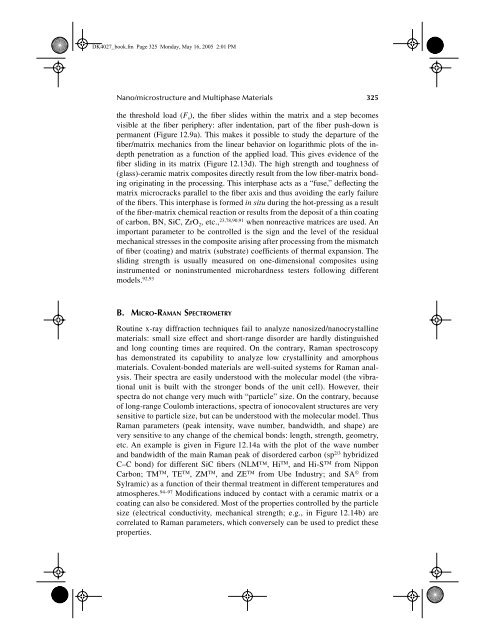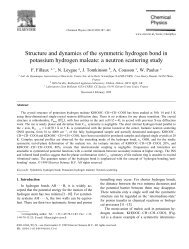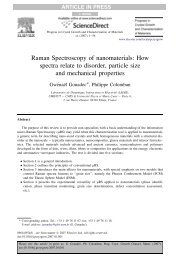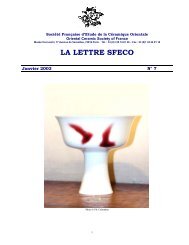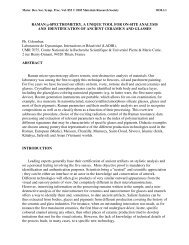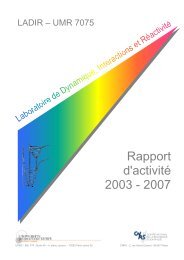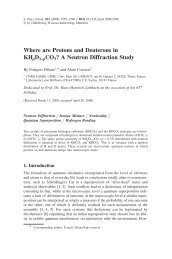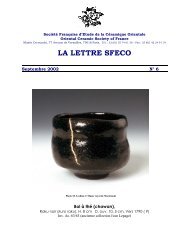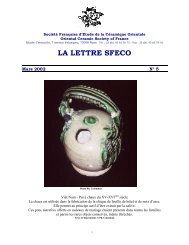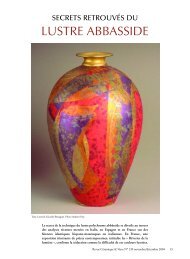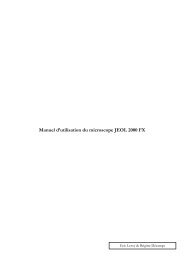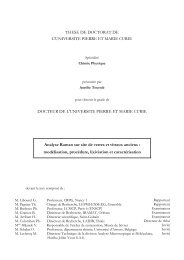12 Nano/microstructure - institut de chimie et des materiaux paris-est
12 Nano/microstructure - institut de chimie et des materiaux paris-est
12 Nano/microstructure - institut de chimie et des materiaux paris-est
- No tags were found...
Create successful ePaper yourself
Turn your PDF publications into a flip-book with our unique Google optimized e-Paper software.
DK4027_book.fm Page 325 Monday, May 16, 2005 2:01 PM<strong>Nano</strong>/<strong>microstructure</strong> and Multiphase Materials 325the threshold load (F s ), the fiber sli<strong>de</strong>s within the matrix and a step becomesvisible at the fiber periphery: after in<strong>de</strong>ntation, part of the fiber push-down ispermanent (Figure <strong>12</strong>.9a). This makes it possible to study the <strong>de</strong>parture of thefiber/matrix mechanics from the linear behavior on logarithmic plots of the in<strong>de</strong>pthpen<strong>et</strong>ration as a function of the applied load. This gives evi<strong>de</strong>nce of thefiber sliding in its matrix (Figure <strong>12</strong>.13d). The high strength and toughness of(glass)-ceramic matrix composites directly result from the low fiber-matrix bondingoriginating in the processing. This interphase acts as a “fuse,” <strong>de</strong>flecting thematrix microcracks parallel to the fiber axis and thus avoiding the early failureof the fibers. This interphase is formed in situ during the hot-pressing as a resultof the fiber-matrix chemical reaction or results from the <strong>de</strong>posit of a thin coatingof carbon, BN, SiC, ZrO 2 , <strong>et</strong>c., 23,78,90,91 when nonreactive matrices are used. Animportant param<strong>et</strong>er to be controlled is the sign and the level of the residualmechanical stresses in the composite arising after processing from the mismatchof fiber (coating) and matrix (substrate) coefficients of thermal expansion. Thesliding strength is usually measured on one-dimensional composites usinginstrumented or noninstrumented microhardness t<strong>est</strong>ers following differentmo<strong>de</strong>ls. 92,93B. MICRO-RAMAN SPECTROMETRYRoutine x-ray diffraction techniques fail to analyze nanosized/nanocrystallinematerials: small size effect and short-range disor<strong>de</strong>r are hardly distinguishedand long counting times are required. On the contrary, Raman spectroscopyhas <strong>de</strong>monstrated its capability to analyze low crystallinity and amorphousmaterials. Covalent-bon<strong>de</strong>d materials are well-suited systems for Raman analysis.Their spectra are easily un<strong>de</strong>rstood with the molecular mo<strong>de</strong>l (the vibrationalunit is built with the stronger bonds of the unit cell). However, theirspectra do not change very much with “particle” size. On the contrary, becauseof long-range Coulomb interactions, spectra of ionocovalent structures are verysensitive to particle size, but can be un<strong>de</strong>rstood with the molecular mo<strong>de</strong>l. ThusRaman param<strong>et</strong>ers (peak intensity, wave number, bandwidth, and shape) arevery sensitive to any change of the chemical bonds: length, strength, geom<strong>et</strong>ry,<strong>et</strong>c. An example is given in Figure <strong>12</strong>.14a with the plot of the wave numberand bandwidth of the main Raman peak of disor<strong>de</strong>red carbon (sp 2/3 hybridizedC–C bond) for different SiC fibers (NLM, Hi TM , and Hi-S TM from NipponCarbon; TM TM , TE TM , ZM TM , and ZE TM from Ube Industry; and SA © fromSylramic) as a function of their thermal treatment in different temperatures andatmospheres. 94–97 Modifications induced by contact with a ceramic matrix or acoating can also be consi<strong>de</strong>red. Most of the properties controlled by the particlesize (electrical conductivity, mechanical strength; e.g., in Figure <strong>12</strong>.14b) arecorrelated to Raman param<strong>et</strong>ers, which conversely can be used to predict theseproperties.


